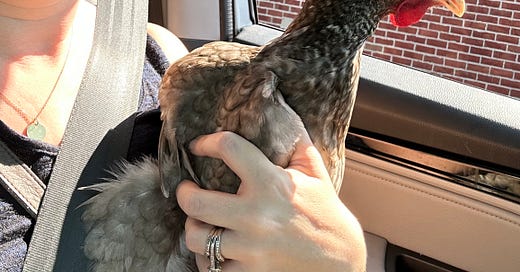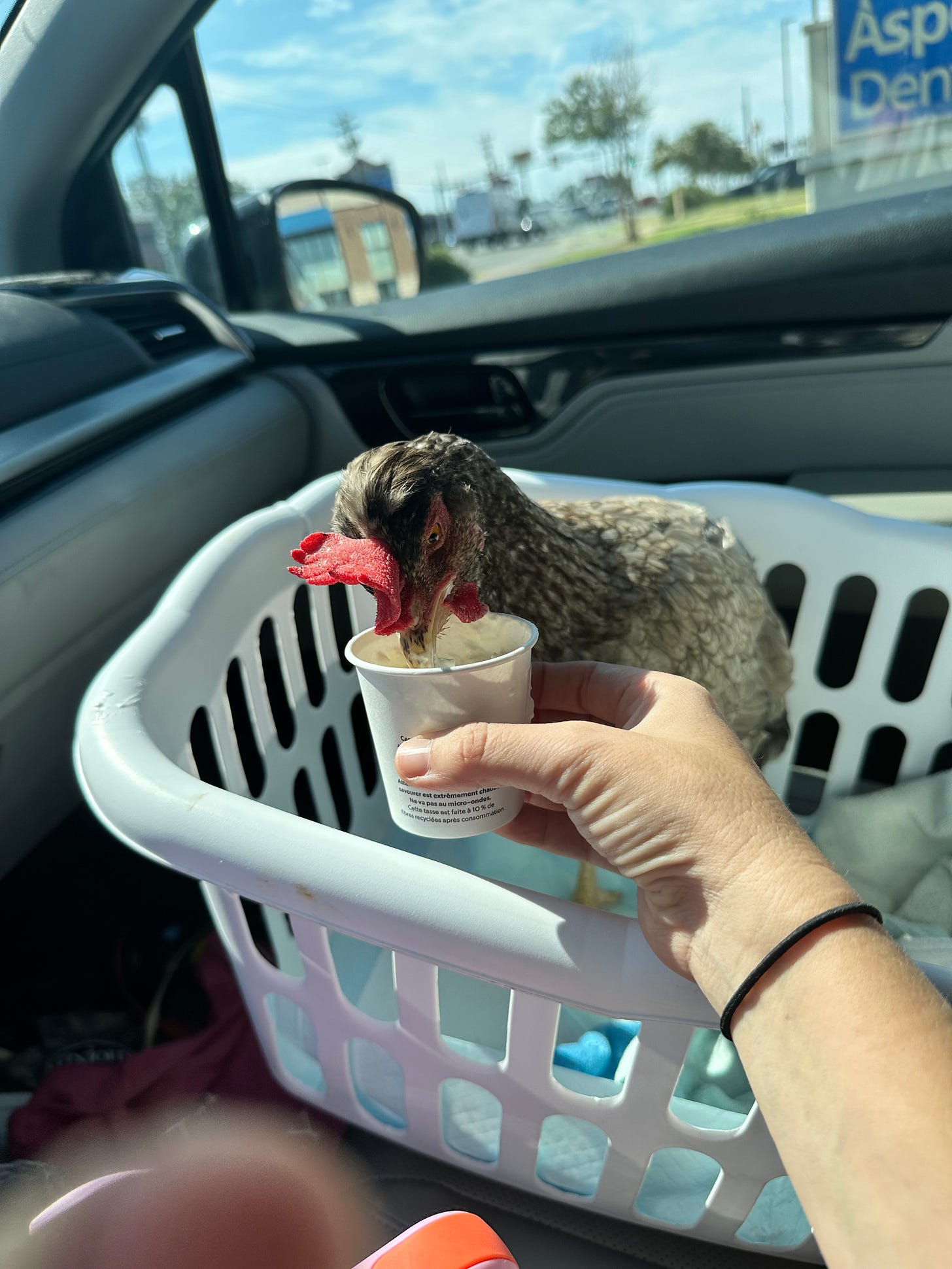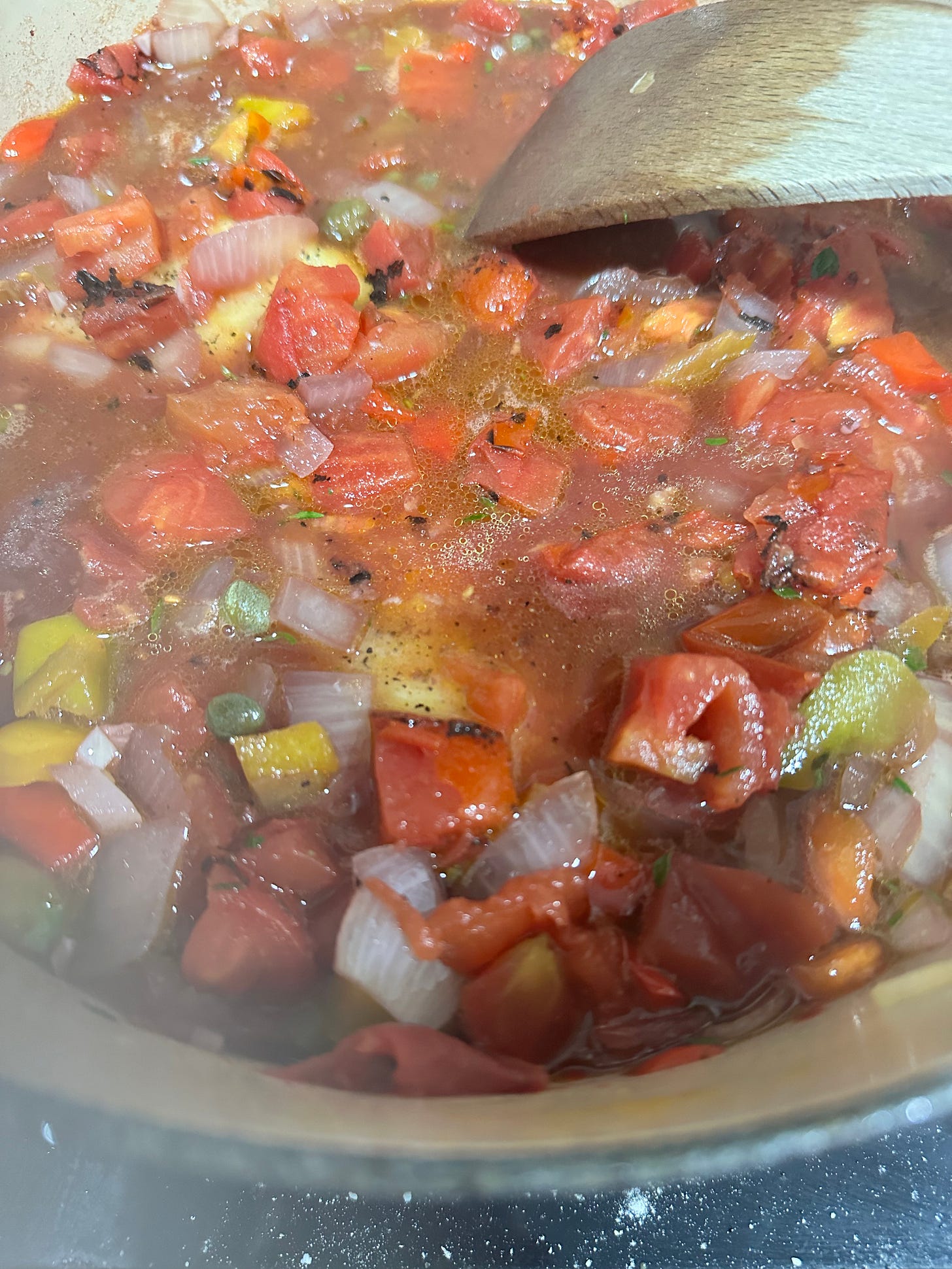The Dark Irony of a Chicken Recipe
The flock recovers, but chicken cacciatore is always an option.
Last week, I took a chicken to the vet.
Now look, I did promise my husband that when we got the chickens, I would be fine with — well, you know. And I’ve become fairly adept at chicken medicine! I have a whole cabinet full of treatment options, I can administer ivermectin (though this really is the horse dewormer, so I can’t be counted on if you do get COVID), and, while I’m not enthusiastic about it, even Kevin can’t be a pet forever.
But there’s a third option, it turns out, between home veterinary medicine and prepping for the stock pot, and that is an illness that only moderately incapacitates a chicken but has the potential to wipe out a flock — and no one really wants bird flu. So off Gilly went to the farm vet, which was exactly like I wanted it to be: seen in a bar with horse stalls and vague bovine treatment methods printed on looseleaf paper and stuck to the walls, country music blaring, and a vet with a Guy Fieri-like habit of wearing his sunglasses backwards.
She has an upper respiratory infection.
A cold.
The chicken has a cold.
Gilly got anti-biotics, I think because the vet felt a little sorry for me. And because we both needed a treat, we stopped at Starbucks for a PSL and a pup cup, which both she and the Starbucks employees enjoyed.
Unfortunately for me, my star green-egger is now a house chicken, wearing a diaper I swore I’d never buy because I’m not that kind of chicken tender, and is cut off from her flock for seven days while she drinks medicine-laced water and lives like a queen in my office, because when you go to the farm vet, they generally expect that you also treat your animals for illness.
I won’t complicate this with any religious insight. Gilly’s fine and no one else is sick (yet), so I don’t have any masterful thoughts on whether she’s providing a commentary on the fragility of creation. But the presence of a chicken really does amp up the quality of service at Starbucks.
I finished out the day by making chicken cacciatore, which, while one of my favorite meals, happens to be darkly ironic in light of the day’s festivities. The French have coq au vin for when things go haywire with poultry and the Italians have hunter’s stew, and both are pretty generally come-with-what-you-have, as long as you also have the chicken and the wine. Wine is mandatory.
Chicken Cacciatore
The traditional “cacciatore,” or “hunter’s stew” is mostly a hodgepodge of anything available, braised in cheap red wine and tomatoes. I’ve used everything from chili fixings to fresh vegetables — the only factor that remains true is the wine. No fancy stuff. Carlo Rossi, in the jug, which you can get stocked next to the boxed wine at Kroger or your local affiliate, usually on sale because no one buys it except for dago trash like me (and there aren’t many of us south of the Mason-Dixon, I’ve learned).
2-3 lbs bone in, skin on chicken thighs
1/4 cup flour
Salt and pepper
3-4 tablespoons olive oil
1 large onion
1 moderately large yellow pepper
4-5 cloves of garlic depending on your mood
3/4 cup red wine
3/4 cup chicken broth
1 tsp oregano
1 tsp thyme
2 10oz cans, fire roasted tomatoes
1/4 capers (or more or less to taste)
Fresh basil for plating
The recipe is simple, and you can start it as early as lunchtime, in case you have things to do over the course of the afternoon. Like most Italian “gravies,” it gets better the longer the braise is allowed to do its thing.
Pat the chicken thighs dry on all sides, season with salt and pepper, and dredge the chicken in the flour, shaking off any excess. Spread the olive oil over the bottom of a pan or dutch oven and heat it over medium to high heat. When the oil begins to sizzle, drop your dredged chicken skin side down into the pan, lower the heat to medium, and cook the chicken for about 8-10 minutes until brown. Flip the chicken, cook on the other side.
Chicken will cook faster and brown better if its not crowded together in the pan, so feel free to cook the chicken in a couple of batches, just replace the oil and reheat between chicken brownings.
Remove the chicken, then drop in your onions, peppers, and garlic. I like yellow peppers because everything else in this recipe is brown, green, or red, but if you like a more monotonous tone to your meals, feel free to use whatever makes you happy. Some people add mushrooms here. My children think they’re gross and won’t eat them.
Saute the veggie mix over medium heat until the onion and the pepper are soft. Season with a little salt and pepper. Then add the wine. Raise the heat to high, get the wine to boil, lower the heat to a simmer and let about half the wine cook off, until your onions and peppers are swimming in a sort of purple goo (this is also cooking off the alcohol, sorry). Add your chicken broth, the contents of your tomato cans, your oregano and thyme, and your capers. I tend to use fire roasted or chili-ready tomatoes because that’s all I had one time and it improved the flavor enough that a switch was necessary. They are, ultimately, sweeter than stewed or regular diced tomatoes. The shape of the tomatoes is also irrelevant — if you can’t *see* tomatoes while eating them, using crushed tomatoes is fine, but your sauce will look different — less chunky.
Drop your chicken thighs back in, heat the whole mess to a boil, then drop down to a low simmer for at least 20 minutes (but you can keep it going up to 2 hours). If you’re okay with a thin sauce, you can serve the chicken and the stew together over pasta without any further steps. Drop the chicken and sauce over noodles cooked to package directions, top with torn basil leaves and some shredded parmesan.
If you’d prefer a thicker sauce, add a bit of flour, return the stew to boil, lower to medium and stir as the sauce thickens. You’ll need to add more salt and pepper if you add flour, so make sure to taste the sauce before you serve.






